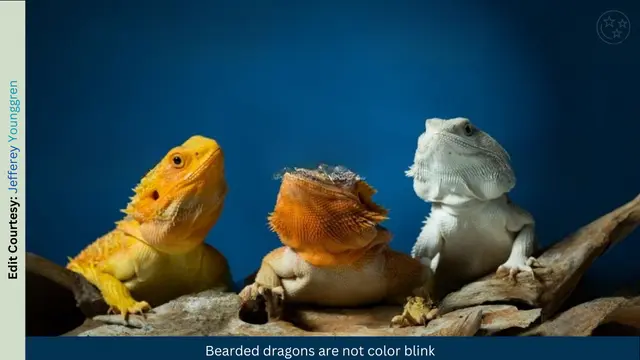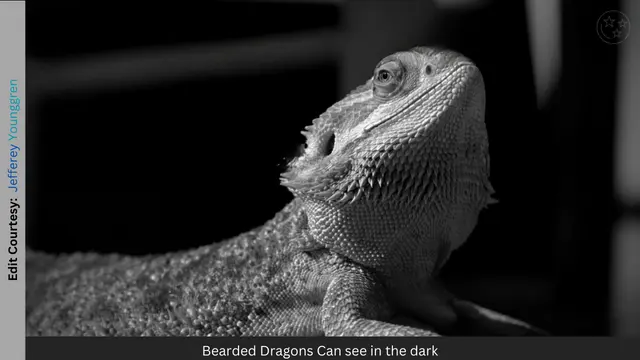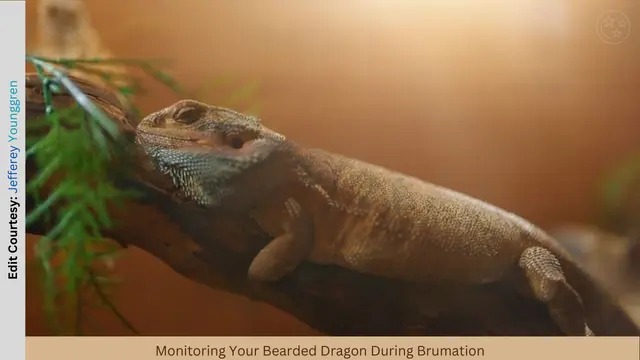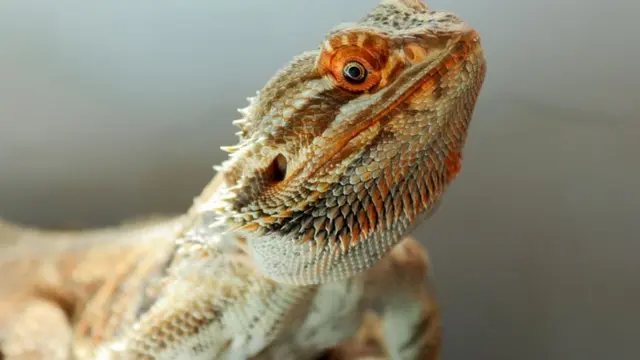If you’re like me, then you’ve probably spent hours gazing into your pet bearded dragon’s big eyes wondering what it sees.
Well, let’s find out!
Bearded dragons have excellent vision and depth perception (though it’s not that much). They can see things from a distance and pick out objects clearly. They can also see colors better than humans. However, they are unable to see black-and-white objects or complete darkness.
So, if you want to know all about the vision of these wonderful creatures, keep reading!
You won’t regret learning more about these amazing reptiles – who knows, maybe it will even give you insight into how your own pet is seeing the world around him or her!
How Do Bearded Dragons See The World
It’s no secret that they have excellent eyesight – in fact, their vision is so sharp that it almost feels like they can see into our souls.
But what exactly do these scaly wonders of nature see?
To understand this better, let us take a look at how bearded dragons perceive objects and light sources differently from humans.
For starters, their eyes are designed to detect movement rather than details; this means that bearded dragons rely more heavily on motion detection when forming an image of the surrounding environment.
Further, due to the presence of tapeta lucida (a reflective layer) in their eye structure, bearded dragons are able to distinguish colors even under dim lighting conditions much better than us mere mortals.
So while we may struggle to make out shapes and features in low-light environments, beardies can easily discern color variations and pick up any small movements or changes within its immediate vicinity.
This heightened sense of perception serves as an invaluable asset for them in both hunting prey and avoiding predators in the wild.
Do Bearded Dragons Have Good Eyesight?
Bearded dragons are equipped with excellent vision, which helps them survive in their natural environment and interact with humans.
They are great at seeing things from a distance (like 30 feet away) and have a wide field of view.
Beardie also has excellent color perception and can see all the colors of the rainbow which screams about their better eyesight.
Here’s what you need to know about the eyesight of these lizards:
- They can see up to 10 meters away, making them particularly adept hunters.
- They have two sets of eyelids, one of which functions as a protective shield while they sleep during the day.
- Their eyes contain ultraviolet-sensitive cones, allowing them to detect UV light much as some species of birds or reptiles do.
Bearded dragons rely heavily on their sense of sight for hunting prey, avoiding predators, and navigating their surroundings.
Their powerful vision allows bearded dragons to spot potential threats before they reach them and also aids in detecting food sources from afar.
This makes it easier for them to find food without having to waste energy searching around aimlessly.

Can Bearded Dragons See In Color?
Yes, bearded dragons can see in color! The dragon’s eye allows it to sense the color spectrum from blue to red. This means they are able to recognize objects of different colors as well as identify prey in their natural habitat.
Bearded dragons use their eyesight to observe movements and changes around them. Their vision is so sharp that they can even tell if something is alive or not without touching it!
Additionally, these reptiles can distinguish between light and dark shades easily too; which comes in handy when looking out for potential dangers such as hawks or other large birds of prey.
Their ability to see small things clearly also aids them in finding tiny insects like ants or crickets which make up a part of their diet.
So while they may not need colorful decorations or toys inside their tank, having bright items arranged aesthetically will surely bring joy to your pet lizard’s life!

Can Bearded Dragons See In The Dark?
Continuing on from the previous section, it’s important to understand how well-bearded dragons can see in the dark. They’re able to distinguish shapes and colors even when there’s no light present!
Bearded dragons are capable of seeing more clearly at night because their eyes contain rods that help them detect faint amounts of light. This allows them to better navigate their environment without needing bright illumination.
Additionally, they use this same capability to find food and prey in darker settings or during early morning or late evening hours.
It’s clear that bearded dragons do have some sort of vision in the dark; however, it’s not quite as strong or accurate as our own.
That being said, they make up for this by using other senses such as smell and hearing which help them locate things with ease despite any lack of visual acuity.
How Far Can Bearded Dragons See?
Bearded dragons have surprisingly good vision.
Research has shown that bearded dragons can see objects up to 30 feet away, which is four times farther than humans!
This means they are able to detect movement and navigate their environment with ease. They also have excellent night vision, allowing them to find food even in the dark.
In addition, beardies come equipped with a unique feature called binocular vision, which allows them to easily focus on objects far off in the distance.
Bearded Dragons Don’t Have The Best Depth Perception
It looks like it can see everything! But here’s the truth: Bearded dragons don’t have great vision or depth perception.
Due to their eyes being on opposite sides of their heads, bearded dragons have poor depth perception. They may run into things or jump from heights without realizing it.
In spite of some sources indicating that bearded dragons have good depth perception, the general consensus appears to be that they do not.
They mainly differentiate between hues of blue and yellow, so reds and greens look all the same to them.
Their eyes also lack sharp focus; instead, they rely on using movement detection to monitor their surroundings.
Furthermore, bearded dragons struggle greatly with judging distance and depth – especially over short distances – due to the shape of their eye sockets which restricts peripheral vision.
In other words, even though they have decent binocular vision (the ability for both eyes to focus on one object) when looking directly forward, any obstacles close by may go unnoticed because of limited side-to-side sight range.
| Poor | Good |
|---|---|
| Color Detection | Movement Detection |
| Sharp Focus | Binocular Vision |
| Depth Perception | Side-to-Side Sight Range |

Do Baby Bearded Dragons Need Red Light At Night?
Studies suggest that they can see twice as far and with fifty percent more clarity than humans! So it stands to reason that baby beardies need a good source of light in order to thrive.
Red light is typically used at night for young dragons because it does not disrupt their natural circadian rhythm like other kinds of lighting would. Red light helps the little ones stay on schedule so they get adequate rest during nighttime hours.
Besides, red lighting helps them recognize when it’s time to start their day by simulating sunrise and sunset. So it’s better to give your beardie red light at night.
How To Aid Your Beardie’s Vision?
1. Lighting in an appropriate manner
Beardies require specific lighting to maintain good vision. They need a source of UVA and UVB light to keep their bones healthy and maintain their vision. Providing a full-spectrum light that emits both types of light will ensure that your beardie can see correctly.
2. Keeping the tank clean
Dirty tanks can cause eye infections in beardies. Cleaning the tank regularly and ensuring that there is no buildup of feces, uneaten food, or other debris will reduce the risk of eye infections.
3. Irritating Substances
Certain types of substrate, such as sand, can irritate a beardie’s eyes. Using a substrate that does not cause eye irritation, such as reptile carpet or paper towels, will help maintain good eye health.
4. Controlling the temperature of the tank
Maintaining the proper temperature in the tank is essential for a beardie’s overall health, including their vision. The temperature in the tank should range from 75-85 degrees Fahrenheit. If the temperature is too low, your beardie may not be able to see correctly.
5. Offering a Balanced Diet
A balanced diet is crucial for maintaining a beardie’s health and vision. They require a mix of vegetables, fruits, and insects to get all the nutrients they need. Feeding a varied diet will ensure that they receive the vitamins and minerals necessary to keep their vision healthy.
6. Offering toys
Beardies are intelligent creatures that require mental stimulation. Providing toys and enrichment will help keep them mentally healthy and engaged. This mental stimulation can aid in maintaining good vision by reducing stress and promoting overall well-being.
Can Bearded Dragons See Infrared Light
Yes, bearded dragons can actually see infrared light! This is due to a special pigment called melanin that’s found in their eyes. The pigments allow them to detect heat from the environment around them, which helps them hunt for food and navigate their surroundings.
Though some critics don’t believe that bearded dragons can see infrared light, however, it is generally agreed that leaving an infrared light on at night is safe for bearded dragons because it does not negatively impact their life cycle and helps keep them warm
The combination of infrared detection and improved visibility under lowlight conditions make bearded dragons some of the most efficient hunters out there – giving them an edge over many other reptiles that rely solely on visible light for navigation and perception.
What Does A Bearded Dragons Vision Look Like
Well, imagine if you were to put on a pair of glasses that only had two colors: yellow and blue. That is essentially what it looks like for a bearded dragon, as their vision is based primarily around those two specific wavelengths.
They can even detect subtle changes in shadows which helps them stay alert during the day and night. Interestingly, they are able to see ultraviolet light too, although not with perfect clarity.
The world through the eyes of a bearded dragon may look like something from an ’80s arcade game; yet despite its simplicity, there’s still plenty of beauty in it – just ask any one of these charming lizards!
After all, even though our sight may be superior, we’ve got nothing on their ability to adapt and survive against all odds.
Can Bearded Dragons See Glass
Yes, bearded dragons do have good vision. They can see in color and also distinguish objects from their surroundings. This is especially true for glass surfaces as they can clearly see through them, making glass a great choice for enclosures.
Bearded dragons are diurnal creatures which means that they are active during the day and sleep at night like us humans.
This means that having a clear view of the world around them gives them an advantage when hunting or trying to avoid predators.
Glass provides this clarity with its transparency so it’s no wonder why these reptiles love being able to view their environment through it.
Glass also helps keep humidity levels consistent within the enclosure since there isn’t any ventilation required and it’s easy to clean.
Can Bearded Dragons See White Color
They are able to see colors like white quite well and accurately.
Their eyesight is actually more sophisticated than one might think; in fact, they can even distinguish between different textures! Here are some amazing facts about their vision:
- Bearded dragons possess two sets of eyelids – a transparent set that allows them to see out of the eye as well as a colored set that provides protection from bright light.
- Their retinas contain both cone and rod cells enabling them to detect color and motion respectively.
- They also have specialized areas within the retina responsible for detecting movement – aiding them when hunting prey or avoiding predators.
Bearded dragons use their eyesight to determine the size and shape of objects around them, such as food items, potential mates, nesting sites, etc., allowing them to navigate through their environment with ease.
Additionally, they rely on visual cues when communicating with other members of their species in order to establish dominance or show submission.
Conclusion
It’s a widely accepted belief that bearded dragons have good vision. But is it true? From my research, I can confidently say that the answer is yes!
Bearded dragons have excellent eyesight and can see in color, infrared light, and even at night. They are also able to accurately spot prey from a distance of up to 30 feet away.
What makes their vision so incredible? Well, they possess two sets of eyelids which may give them superior depth perception compared to other species.
Additionally, their eyes contain three different types of cones — red/green, blue/yellow, and ultraviolet — allowing them to detect more colors than humans can.
Not only that but they’re even capable of seeing through glass if there isn’t any reflection or glare on the surface.
We should continue to explore this fascinating subject further as understanding the world around us can be both educational and rewarding!
